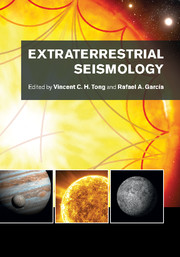Book contents
- Frontmatter
- Contents
- List of contributors
- Preface
- Acknowledgements
- List of abbreviations
- Planetary seismology: High risk, high return
- A bright outlook for helio- and asteroseismology
- Part I Observation and space missions
- Part II Data and physical parameters
- Part III Modeling approaches
- Part IV Discoveries of physical structures and processes
- 11 Asteroseismology of red giant stars
- 12 A helioseismic view of the Sun's internal structure and dynamics
- 13 Recent discoveries of structures and physical processes in local helioseismology
- 14 Seismology of giant planets
- 15 Seismicity and interior structure of the Moon
- Part V Interdisciplinary research involving planetary and astrophysical sciences
- Part VI Interdisciplinary research involving terrestrial seismology
- References
- Index
14 - Seismology of giant planets
from Part IV - Discoveries of physical structures and processes
Published online by Cambridge University Press: 05 July 2015
- Frontmatter
- Contents
- List of contributors
- Preface
- Acknowledgements
- List of abbreviations
- Planetary seismology: High risk, high return
- A bright outlook for helio- and asteroseismology
- Part I Observation and space missions
- Part II Data and physical parameters
- Part III Modeling approaches
- Part IV Discoveries of physical structures and processes
- 11 Asteroseismology of red giant stars
- 12 A helioseismic view of the Sun's internal structure and dynamics
- 13 Recent discoveries of structures and physical processes in local helioseismology
- 14 Seismology of giant planets
- 15 Seismicity and interior structure of the Moon
- Part V Interdisciplinary research involving planetary and astrophysical sciences
- Part VI Interdisciplinary research involving terrestrial seismology
- References
- Index
Summary
Introduction
Seismology of giant planets has long been considered as both a potentially powerful tool for probing their interiors and a natural extension of helioseismology. Giant planets are mostly fluid and convective, which makes their seismology much closer to that of solar-like stars than that of terrestrial planets. For this, we refer the reader to the introductory chapters about helio- and asteroseismology for basic concepts and vocabulary. By being the biggest and closest, Jupiter has attracted most of the efforts in this domain. Theoretical studies started in the late 1970s and the first observational attempts were undertaken in the late 1980s. So far, the two major results are a clear detection of acoustic oscillations of Jupiter (Gaulme et al., 2011), and the signature of Saturn f modes in the rings by the NASA Cassini spacecraft (Hedman and Nicholson, 2013).
This chapter first examines the theoretical motivation for developing seismology of giant planets, which mainly stands on an inaccurate knowledge of their interiors (Section 14.2). The next sections focus on two crucial points: why seismology can be done on giant planets (14.3), and what can it bring in terms of physics (14.4). We then present the observation techniques that have been used or envisioned to detect oscillations (14.5), and the main observational results (14.6).
Interior structure
Giant planets are planets massive enough to have retained the hydrogen and helium initially present in the circumstellar disk that led to the formation of the central star and its planets. The study of their composition is important in understanding both the mechanisms enabling their formation and the origins of planetary systems, in particular our own. Unfortunately, composition determination is complicated by the fact that their interiors are thought not to be homogeneous, so that spectroscopic determinations of atmospheric abundances are probably not representative of the planet as a whole.
- Type
- Chapter
- Information
- Extraterrestrial Seismology , pp. 189 - 202Publisher: Cambridge University PressPrint publication year: 2015
- 8
- Cited by

